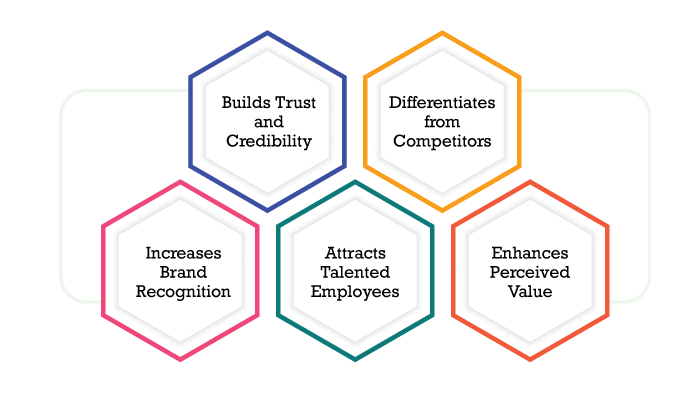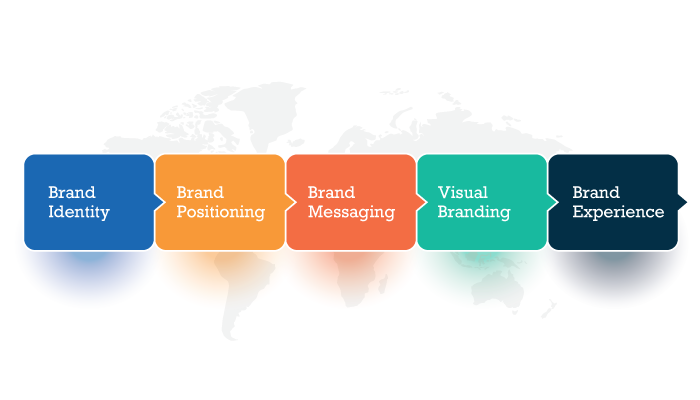Table of Contents
Corporate Branding.
This is the name of the game in 2023. If a business wants to be successful in today’s competitive landscape, they need to create a BRAND.
And let us tell, it is much more difficult than creating a company.
But what is it? Why is it important? How do you do it? Well, there are endless questions surrounding the concept.
Especially if you are someone interesting in creating a good brand image for your company and entirely new to the concept. Or your manager have tasked you to work on the concept.
In either case, we have got you covered.
This blog is all about answering different questions related to corporate branding. And by the end of it, you will have answer to all of them.
So, buckle up and let’s get right into it, starting with:
What is Corporate Branding?

First things first, what is corporate branding.
Well to understand the concept of corporate branding, one must understand the word corporate brand.
This means the identity of a brand, or it’s image in public eye.
Based on that, Corporate branding refers to the process of creating and promoting a company’s brand identity and image across various touchpoints to establish a unique and recognizable presence in the market.
Thing can be a huge thing. As it involves the consistent use of visual elements, messaging, values, and experiences to shape how the company is perceived by its target audience, stakeholders, and the public.
Seems quite interesting right? Well, it’s just as important as it’s interesting. How and why, we shall be discussing in the next section.
The Importance of Corporate Branding

Why create a brand? Why do you need to invest in it?
Because it’s important.
As to why it’s important, there are various reason. Let’s discuss what these are, below:
1. Builds Trust and Credibility
One of the most important reason why people invest in corporate branding is because it builds trust and credibility.
Let us explain.
A strong corporate brand helps establish trust and credibility among customers by showing them what the brand is all about.
This makes them – the customer more likely to choose your products or services over competitors.
2. Differentiates from Competitors
It goes without saying that everyone wants to stand out of the rest, be above the crowd, the star that outshines the rest.
That’s exactly what corporate branding helps you do.
Look at this way: Corporate branding sets your company apart from competitors by creating a unique identity and positioning in the market.
This means huge business growth. In fact, this is the reason why they pay mobile app development companies so much to create their own brand of mobile apps.
3. Increases Brand Recognition
Every company wants to be recognition from their target customers. They want the customers to see the logo and now it’s a great brand.
A well-executed corporate branding strategy ensures that your brand is easily recognizable and memorable, fostering repeat business and customer loyalty.
4. Attracts Talented Employees
Company doesn’t only want to attract customer, but they also want to attract talent who can take the company forward.
A strong corporate brand attracts top talent, as it reflects a positive and appealing company culture and values.
For instance, companies like Apple and Amazon has created such a huge brand image that everyone wants to work for them. With the right corporate branding strategy, you can do just that.
5. Enhances Perceived Value
Lastly, effective branding enhances the perceived value of products or services, enabling companies to command premium prices.
A good example of this is luxury products being priced that much higher then their actual value and still selling in great numbers, earning company huge revenue.
So, this is why corporate branding is so important. And with this out of the way, let’s discuss key components of corporate branding below:
Key Components of Corporate Branding

So, what are the key components that makes up a corporate brand? Well, this is one of the most important things to know about the concept of corporate branding.
Speaking of which, these components are, as mentioned below:
(I) Brand Identity
The first and arugbly the most important one is, brand identity.
This component encompasses the visual elements that represent a company’s brand. This includes:
- Logo
- Color Palette
- Typography
- Design Elements
Moreover, it creates a distinct and recognizable image that helps customers identify and differentiate the brand from its competitors.
(II) Brand Positioning
This is a rather interesting one, so read carefully.
The term “brand positioning” refers to how a company wants its brand to be perceived in the market relative to its competitors.
It involves identifying and communicating the unique value proposition and key differentiators that set the brand apart.
When done right, positioning helps establish a strong market position and target the right audience.
(III) Brand Messaging
Brand messaging involves developing a clear and consistent communication strategy that conveys the brand’s values, personality, and key messages to the target audience.
This component covers crafting compelling taglines, mission statements, and value propositions that resonate with customers and align with the brand identity.
(IV) Visual Branding
The says it all.
You see, this one is all about the visual elements that represent the brand, including the logo, colors, typography, and design elements.
Consistency in visual branding across all marketing materials, website, social media profiles, and packaging helps build brand recognition and reinforce the brand identity.
(V) Brand Experience
And finally the, Brand experience.
This concept is all about the overall perception and interaction customers have with a brand at various touchpoints.
Meaning It covers everything from the website and product packaging to customer service and post-purchase support. Providing a positive and consistent brand experience helps build trust, loyalty, and advocacy among customers.
With this out of the way and you understanding the full extent of corporate branding elements, it’s time to look at how to create a strong corporate branding strategy.
Crafting a Strong Corporate Branding Strategy

How do I create a corporate branding strategy?
This is probably the most asked question about corporate branding and rightfully so. So, how do you do it? Well, it’s actually quite simple.
However, doing it right is very important, just as important as brand’s workspace or their app’s home page.
Speaking of which, let’s see what are the steps to creating a market leading branding strategy for your corporate.
1. Define Your Target Audience
Identify and understand your target audience’s demographics, psychographics, needs, and preferences. This will help tailor your branding efforts to resonate with your ideal customers and create a more focused and effective strategy.
2. Identify Your Unique Value Proposition
Determine what sets your company apart from competitors and articulate it clearly. Your unique value proposition should communicate the benefits and value your products or services offer to customers, highlighting why they should choose your brand over others.
3. Develop a Compelling Brand Story
Craft a compelling narrative that communicates your brand’s history, values, mission, and vision. A strong brand story can emotionally connect with your audience and create a sense of authenticity and trust.
4. Consistent Branding Across Channels
Ensure that your brand identity, messaging, and visual elements are consistent across all marketing channels, including your website, social media platforms, advertising campaigns, and offline materials. Consistency helps reinforce brand recognition and build a cohesive brand image.
5. Engage and Interact with Your Audience
Actively engage with your target audience through social media, content marketing, events, and customer support. Encourage feedback, respond to inquiries, and create meaningful interactions to foster a sense of community and build brand loyalty.
This is how you can create corporate brand strategy of your own. But if you think you need expert help, we highly recommended that you go for corporate branding services.
Successful Corporate Branding Examples
We are all familiar with the term “learn from the best”.
And that’s the right way to do thing. Therefore, if you want to create a market leading strategy for corporate branding, you should learn from companies who are doing it right.
Some corporate branding examples are, as mentioned below:
Apple

Apple is known for its simplistic and innovative brand identity, focusing on sleek design, user-friendly interfaces, and cutting-edge technology.
Their branding conveys a sense of exclusivity and premium quality, appealing to tech-savvy consumers.
Nike

Nike’s branding revolves around empowerment and athleticism.
They inspire individuals to push their limits and embrace their potential through their “Just Do It” tagline and campaigns featuring successful athletes.
Nike’s brand is synonymous with performance and motivation.
Coca-Cola

Coca-Cola has built its brand around happiness and nostalgia.
Through their advertising campaigns and iconic red and white branding, they evoke emotions of joy, togetherness, and memories, making their brand deeply ingrained in popular culture.
These are the three best corporate branding examples.
Measuring the Success of Corporate Branding
Suppose you have created a corporate branding strategy and applied it.
But how do you know, if it will be a success or not? Well, measuring success is also big part of corporate branding.
In this section, we will be teaching you some big branding success metric to measure success of the strategy.
| Brand Equity | Brand equity refers to the intangible value and perception that a brand holds in the market. It can be measured through brand recognition, brand loyalty, and perceived brand quality. Increasing brand equity indicates a successful branding strategy. |
| Customer Surveys and Feedback | Conducting surveys and gathering feedback from customers can provide insights into their perception of your brand, satisfaction levels, and likelihood to recommend your brand to others. Positive feedback and high customer satisfaction are indicators of effective branding. |
| Market Share and Revenue Growth | Monitoring market share and revenue growth can indicate the success of your branding efforts. If your brand gains market share and experiences steady revenue growth, it suggests that your brand is resonating with customers and driving business growth. |
| Employee Engagement and Satisfaction | Engaged and satisfied employees can be strong brand advocates. Measure employee engagement and satisfaction levels to assess the impact of your brand internally. Employees who align with and believe in the brand are more likely to deliver a positive brand experience. |
How to Maintain and Evolve Your Corporate Brand?

Even if you have created a corporate branding strategy for your business, you can’t live on that for ever.
You see, in 21st century, the market is super competitive and always evolving. Even to stay afloat, you need to keep improving.
That’s why in this section of the blog, we shall be discussing how you can improve your corporate branding with time and keep the level of success.
Some things you can do are, as mentioned below:
A. Brand Guidelines
Establish comprehensive brand guidelines that outline the proper usage of your brand identity elements, messaging, tone of voice, and design principles.
These guidelines ensure consistency and provide a reference for all brand-related communications.
B. Brand Refresh vs. Rebranding
Determine whether your brand needs a refresh or a complete rebranding. A
Brand refresh involves making subtle changes to elements like the logo or visual identity to modernize the brand, while a rebranding involves a more significant overhaul of the brand’s positioning, messaging, and visual identity.
This is also one of the big reason why top brands like Instagram, AirBnb, and so on are investing in mobile app redesign to make their product appear better visually.
C. Adapting to Changing Market Trends
Stay up-to-date with market trends and evolving customer needs.
Continuously monitor the market, competitors, and customer feedback to identify opportunities for innovation or adaptation that can keep your brand relevant and appealing.
For instance, make sure to refresh the design with latest UI design trends,
D. Managing Brand Reputation
Proactively manage your brand’s reputation by monitoring online mentions, reviews, and social media conversations.
Respond to customer feedback promptly and transparently, addressing any concerns or issues to maintain a positive brand perception.
This is a very important thing that can highly affect the corporate branding in a good way.
E. Leveraging Social Media and Digital Platforms
It goes without saying that 21st century is the age of social media platforms.
That’s why it’s important to use them for corporate branding and to businesses’ advantage.
Utilize social media and digital platforms to amplify your brand’s reach and engage with your audience.
Create meaningful and shareable content, interact with customers, and leverage influencer partnerships to enhance brand visibility and reputation.
You can take it to next level by creating a mobile app or website for your company and market that. This will help you reach way more customers are everyone is using a mobile phone today.
Moving on, corporate branding is very easy to get wrong. That’s why there are some common mistakes that everyone should avoid, let’s see what these are:
Common Corporate Branding Mistakes to Avoid
Let’s have a look at some come corporate branding mistake that you should avoid at all costs. These are, as mentioned below:
1. Inconsistent Branding: Inconsistency in brand identity, messaging, or visual elements can confuse customers and dilute brand recognition. Ensure consistency across all brand touchpoints to reinforce your brand image.
2. Lack of Authenticity: Failing to deliver on brand promises or projecting an inauthentic image can harm brand reputation. Be true to your brand values, mission, and promises to build trust and credibility with your audience.
3. Failing to Adapt to Customer Needs: Ignoring evolving customer needs and market trends can result in a disconnected brand. Stay attuned to customer feedback and market shifts, and adapt your branding strategy accordingly to remain relevant.
4. Neglecting Employee Involvement: Employees play a crucial role in delivering the brand experience. Involve and train employees to embody the brand values and provide consistent customer interactions that align with the brand identity.
5. Ignoring Brand Perception: Disregarding how your brand is perceived by customers and failing to monitor brand sentiment can lead to missed opportunities or potential reputation crises. Regularly assess brand perception and take necessary actions to maintain a positive brand image.
With the mistakes to avoid for corporate branding out of the way, we have come to end of our blog.
Conclusion
Corporate branding, this is the key to the door of success in today’s market that’s growing more and more competitive. There are various companies that offer corporate branding services but if you are looking for that, it’s important to understand the concept, just as we did in this blog. And with this, we conclude the topic.
FAQs
By conducting market research, defining values and mission, designing a memorable logo, creating consistent messaging, and aligning communication channels.
Corporate branding shapes customer perception of reliability, quality, trustworthiness, and emotional connection, leading to loyalty and advocacy.
Yes, corporate branding impacts employee engagement by fostering pride, loyalty, and understanding of company values and goals.
Corporate branding includes behavior, customer service, online presence, social media engagement, and customer experience.
Maintaining consistency, adapting to market trends, overcoming negative publicity, and differentiating from competitors are common challenges.
By using customer surveys, monitoring brand awareness, tracking customer loyalty, analyzing employee satisfaction, and monitoring social media sentiment.





No Comments
Comments are closed.